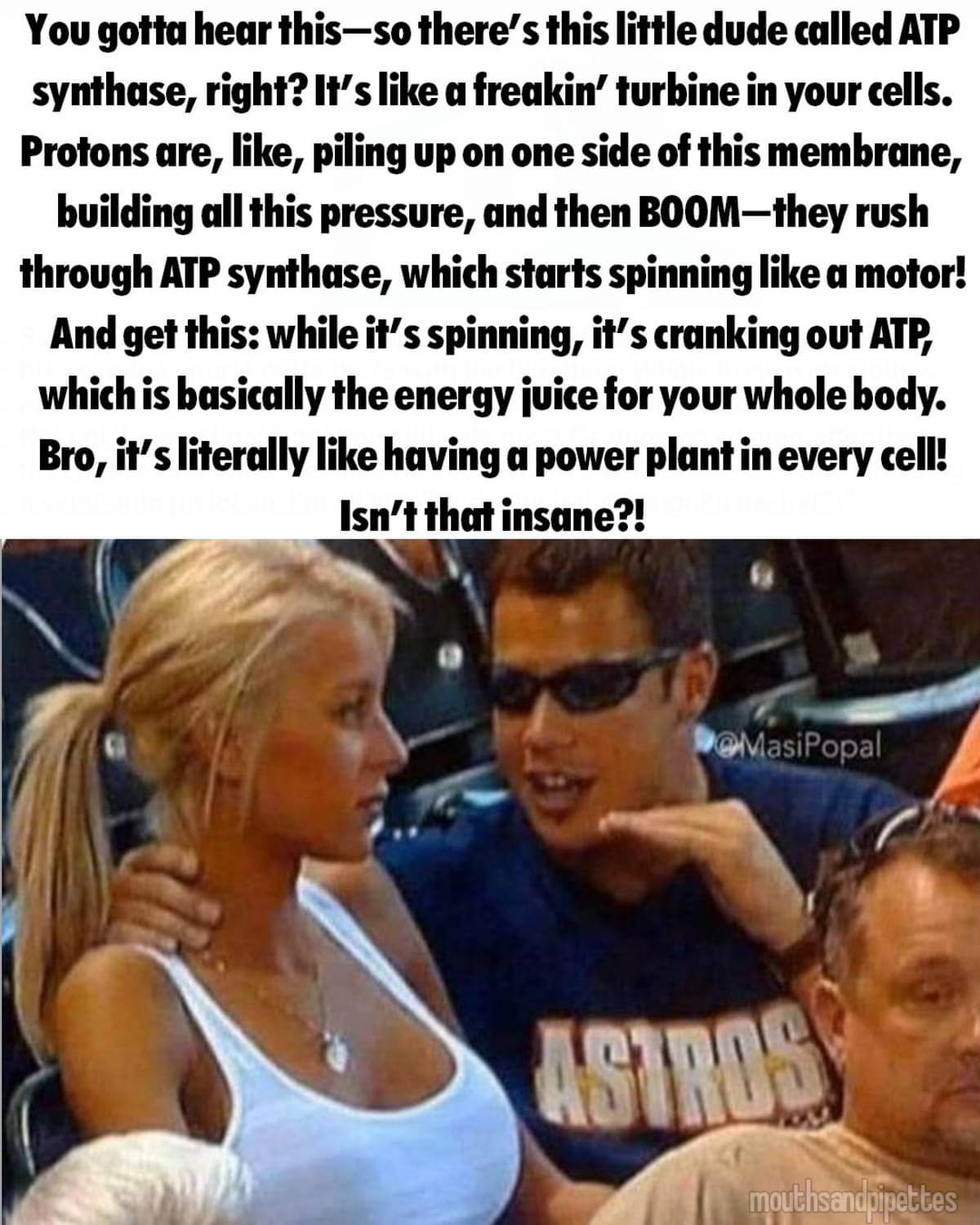this post was submitted on 10 Nov 2024
522 points (98.3% liked)
Science Memes
11021 readers
3826 users here now
Welcome to c/science_memes @ Mander.xyz!
A place for majestic STEMLORD peacocking, as well as memes about the realities of working in a lab.

Rules
- Don't throw mud. Behave like an intellectual and remember the human.
- Keep it rooted (on topic).
- No spam.
- Infographics welcome, get schooled.
This is a science community. We use the Dawkins definition of meme.
Research Committee
Other Mander Communities
Science and Research
Biology and Life Sciences
- !abiogenesis@mander.xyz
- !animal-behavior@mander.xyz
- !anthropology@mander.xyz
- !arachnology@mander.xyz
- !balconygardening@slrpnk.net
- !biodiversity@mander.xyz
- !biology@mander.xyz
- !biophysics@mander.xyz
- !botany@mander.xyz
- !ecology@mander.xyz
- !entomology@mander.xyz
- !fermentation@mander.xyz
- !herpetology@mander.xyz
- !houseplants@mander.xyz
- !medicine@mander.xyz
- !microscopy@mander.xyz
- !mycology@mander.xyz
- !nudibranchs@mander.xyz
- !nutrition@mander.xyz
- !palaeoecology@mander.xyz
- !palaeontology@mander.xyz
- !photosynthesis@mander.xyz
- !plantid@mander.xyz
- !plants@mander.xyz
- !reptiles and amphibians@mander.xyz
Physical Sciences
- !astronomy@mander.xyz
- !chemistry@mander.xyz
- !earthscience@mander.xyz
- !geography@mander.xyz
- !geospatial@mander.xyz
- !nuclear@mander.xyz
- !physics@mander.xyz
- !quantum-computing@mander.xyz
- !spectroscopy@mander.xyz
Humanities and Social Sciences
Practical and Applied Sciences
- !exercise-and sports-science@mander.xyz
- !gardening@mander.xyz
- !self sufficiency@mander.xyz
- !soilscience@slrpnk.net
- !terrariums@mander.xyz
- !timelapse@mander.xyz
Memes
Miscellaneous
founded 2 years ago
MODERATORS
you are viewing a single comment's thread
view the rest of the comments
view the rest of the comments

My biology teacher had this thing where every test you had to submit a question. My question was always the same - how the fuck does atp synthase work?
She did not appreciate my question especially after the first time, but it was always genuine... How the fuck does that shit work? If you understand it, please attempt to put it into words
It has a part that is embedded in a mitochondrial membrane and works as a rotor. The other part is sticking out from the membrane and is responsible for synthesis of ATP from ADP and phosphate. An off-axis part of the rotor pushes the stator, it changes shape and pushes ADP and phosphate together, until they fuse to ATP.
To make the rotor move, it makes use of membrane potential. One side of the membrane has a lot more H⁺ (just protons, really) than the other. The excess H⁺ want to go to the other side. The membrane doesn't let them through. It is hydrophobic on the inside, so it does't let through anything charged (like H⁺) or polar (like water). This is the potential and it has quite a lot of energy. ATP synthase lets the H⁺ through by binding them to the rotor in the membrane in a particular place and releases them in another in such a way that forces the rotor to turn almost a full turn before they can leave and stops it from rotating the other way. As mentioned, the rotation is transfered to the stator, changing its shape and thus creating ATP. As a side note, multiple H⁺ are bound on the rotor along its circumference, so each rotation is powered by the potential energy of multiple protons.
Of course, it's a bit more complicated than that, but I don't think there's anything downright wrong or misleading in what I wrote. I hope I managed to make it understandable. Also, I recommend animations of the synthase on youtube.
I realised I have a sort of explanatory image at hand.
Adenosine triphosphate (ATP) functions as the primary energy currency of the cell, enabling various biological processes. Here's an explanation of how ATP works on a molecular level:
Structure of ATP
ATP is composed of three main components:
Adenine: A nitrogenous base.
Ribose: A five-carbon sugar molecule, which together with adenine forms adenosine.
Three Phosphate Groups: Linked sequentially through high-energy bonds.
Energy Storage and Release
The key to ATP’s function lies in the high-energy bonds between its phosphate groups, particularly the bond between the second (beta) and third (gamma) phosphate groups.
When ATP is hydrolyzed (reacts with water), it loses its terminal (gamma) phosphate group, releasing energy.
The reaction is:
ATP + H2O > ADP + Pi + Energy
The hydrolysis of ATP releases about 30.5 kJ/mol (7.3 kcal/mol) of energy.
This energy is used to perform cellular work, such as muscle contraction, active transport across cell membranes, and chemical synthesis.
Mechanism of ATP Utilization
ATP transfers its phosphate group to another molecule (a process called phosphorylation), making that molecule more reactive.
This is often facilitated by enzymes known as kinases.
Cells couple the exergonic reaction of ATP hydrolysis with endergonic reactions (reactions that require energy).
For example, during muscle contraction, ATP hydrolysis provides the energy for the motor protein myosin to move along actin filaments.
ATP Synthesis
ATP is regenerated from ADP through cellular respiration, which consists of three main stages:
Glycolysis: Breakdown of glucose into pyruvate, producing a small amount of ATP.
Citric Acid Cycle (Krebs Cycle): Further breakdown of metabolic products, generating electron carriers (NADH and FADH2).
Oxidative Phosphorylation:
Electrons from NADH and FADH2 are transferred through the electron transport chain in the inner mitochondrial membrane.
This creates a proton gradient that drives ATP synthesis via ATP synthase.
ATP Synthase Function
ATP synthase is a complex enzyme that synthesizes ATP from ADP and using the energy derived from the proton gradient.
Proton Gradient: Protons flow back into the mitochondrial matrix through ATP synthase.
Rotational Catalysis:
The flow of protons causes the rotation of a part of ATP synthase.
This mechanical energy drives the chemical synthesis of ATP from ADP and .
In summary, ATP serves as a molecular battery, storing energy in its high-energy phosphate bonds and releasing it upon hydrolysis to fuel various cellular activities. Its synthesis and utilization are tightly regulated processes essential for life.
ChatGPT missing the question